The Anne Frank House in Amsterdam
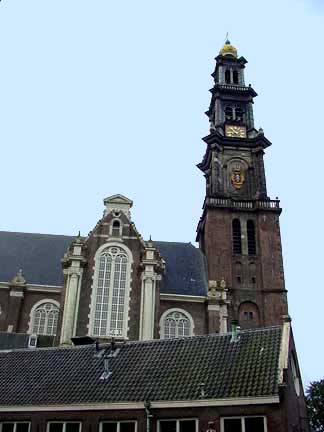 Anne could see this
view of Westerkerk (church) from attic window
Anne could see this
view of Westerkerk (church) from attic window
After leaving the rooms where Anne and
her family lived in the annex, the tour then proceeds up a very
steep staircase to the third floor above the ground floor, or
what Americans would call the fourth floor. On this floor, there
is a large room, 16 feet by 13 feet, which was used as the living
room, dining room, and kitchen as well as the sleeping quarters
for Mr. and Mrs. van Pels. Their son Peter slept outside this
room, in the 10 feet by 6.5 feet hallway space, which has a ladder
up to the attic. The attic is not on the tour, but a mirror has
been placed so that it reflects the attic room, which measures
16 feet by 20 feet. The ladder up to the attic has been closed
off by a piece of glass or plastic which has been affixed to
it to prevent anyone from climbing up it. The attic was used
by the 8 people in hiding for storing food and for hanging up
their laundry. According to Anne's diary, the roof of the attic
leaked.
After about a year in hiding, Ann and
Peter became good friends and they would go up to the attic to
hang out together. There are two very large windows in the attic
of the annex, one overlooking the courtyard in the center of
the block, and the other overlooking the 12-foot space between
the annex and the main building. The photograph above was taken
from ground level, but it shows the side of the Westerkerk which
could be seen from a third attic window, which was very small.
The small hallway space where Peter slept
has a window with a tiny iron balcony, barely big enough to stand
on. The balcony overlooks the narrow open space between the main
building and the annex. One could stand on this tiny balcony
and enjoy the fresh air, while being completely hidden from view,
except for the occupants of the annex behind 265 Prinsengracht.
From the balcony, one could easily climb onto the roof of the
2nd floor passageway between the annex and the front building.
There was no connecting passageway from the third floor to the
annex and no rear windows in the main building on the third floor.
If Peter ever went out onto the balcony or the roof, Anne never
mentioned it in her diary. She described Peter's small room in
great detail and remarked upon the expensive rugs on the floor,
but never mentioned the window nor the balcony.
The large room on the third floor, which
was used as a communal room, was furnished with a sink built
into a cupboard that is still in the room. The cupboard is painted
light yellow with blue trim around the doors. The sink counter
looks like it is made of stone, which was common back then in
Europe. Behind the sink, the wall is covered with metal, instead
of the usual ceramic tile which is used today. The one faucet
in the sink was only for cold water, as there was no water heater
to provide hot running water. Near the sink is an iron stove
(like a pot-bellied stove except that it is square), which has
a stovepipe going through the wall into the chimney for what
was formerly a fireplace. The mantle of the fireplace is still
on the wall. Cooking was done on the two open burners on the
top of this stove. Anne mentioned in her diary that the stove
was also used to burn the garbage, and that the stove was first
used in October, after the occupants had moved in during the
month of July in 1942. The stove used coal which the occupants
got from the coal supplies for the main building.
When the Franks were in hiding in the
annex, the communal room on the third floor was furnished with
a large dining room table and eight chairs in the center, where
they took their meals. A large rectangular chandelier, of the
style associated with Frank Lloyd Wright homes, hung over the
table and the floor was covered by an Oriental rug. The room
has exposed beams on the ceiling, as does Peter's hallway space.
All of the occupants of the annex helped with the cooking and
cleaning; they even made jam from fresh strawberries, according
to Anne's diary.
The top floor of the annex was not originally
connected to the main building, but it is now. An enclosed passageway
with glass walls and roof has been added so that visitors can
now walk from the annex to the main building to see the exhibits
which are on the top floor. Through the glass of the connecting
passageway, on the left-hand side, one can see the same view
of the Westerkerk that Anne and Peter could see from the small
attic window.
In the glass passageway there is a poster
with a quotation from Anne's entry into her diary on October
9, 1942, regarding the gassing of the Jews:
"The English radio says they're
being gassed. I feel terribly upset."
The following quotation, which proves
that the gassing of the Jews was well known, even at this early
date, is from a footnote in The Diary of Anne Frank, the Critical
Edition:
In June 1942 the British press and
the BBC began to refer to the gassings in Poland. Thus the 6
p.m. news on the BBC Home Service on July 9, 1942, included the
following item: "Jews are regularly killed by machinegun
fire, hand grenades - and even poisoned by gas." (BBC Written
Archives Center, Reading)
When Anne wrote on October 9, 1942 in
the original diary (the one that she had received for her birthday
in June 1942), she did not mention the gassing of the Jews. The
entry on that date mentions only that Miep had told her that
Jews were being "dragged from house after house in South
Amsterdam." Anne's original entries are called version A
in the Critical Edition. The quotation that is in the glass passageway
is from version B, which is the diary as rewritten by Anne between
May 20 1944 and August 4, 1944, and published in the Critical
Edition in 1986. Version C in the Critical Edition is the diary
as edited by Otto Frank who chose entries from both version A
and version B, publishing it as "Het Achterhuis" in
1947. In 1952, version C was published by Doubleday & Co.
in America under the title "Anne Frank: the Diary of a Young
Girl."
As published in The Critical Edition,
the following is Anne's entry for October 9, 1942 in version
B, the rewrite, which is also used as the entry for that date
in version C, which was published in 1947 by Otto Frank:
"If it is as bad as this in Holland,
whatever will it be like in the distant and barbarous regions
they are sent to. We assume that most of them are murdered. The
English radio speaks of them being gassed; perhaps that is the
quickest way to die. I feel terribly upset."
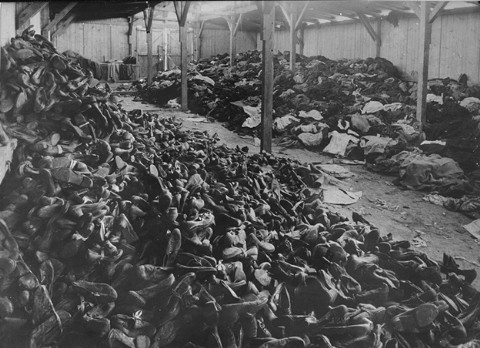
Shoes and clothing
of prisoners who were gassed in Auschwitz
Photo Credit: US Holocaust
Memorial Museum
The photograph above is from the US Holocaust
Memorial Museum in Washington, DC. The caption says that these
shoes and this clothing was taken from Jews who were sent to
the gas chambers in Auschwitz. Among the displays
on the top floor of the Anne Frank House, there is a similar
photograph which shows prisoners at Auschwitz sorting a huge
pile of shoes in one of the clothing warehouses. The caption
says that these are the shoes of the Jews who were gassed.
There is a photograph of Hermann van
Pels on display in the exhibits at the Anne Frank House and the
text accompanying it says that he died in the gas chamber at
Auschwitz in either September or October 1944. Mr. van Pels was
the youngest of the three adult men in the annex; he was born
in 1890 and was a year younger than both Otto Frank and Dr. Fritz
Pfeffer. The exact date of his death is apparently unknown but
there is no doubt that he was gassed. Some sources say that he
was gassed immediately upon arrival. In her book entitled "Anne
Frank, a biography," Melissa Müller wrote the following:
Peter seems to have worked in the
camp post office and he held up well. His father, however, like
Otto Frank and Fritz Pfeffer, was assigned an outdoor job. When
Hermann injured his finger, probably in early October, he gave
up and asked his kapo to assign him to a barracks detail the
next day, even though he must have known how dangerous that was
for anyone who, like himself, was injured or in ill health. And
indeed on that very day, the SS made a clean sweep of the barracks.
Selection. Hermann van Pels fell victim to this arbitrary system.
In a book published by the Anne Frank
Stichting in Amsterdam in 1966, entitled "Anne Frank, A
History for Today" there is the following quotation from
Otto Frank regarding the selection of Hermann van Pels for the
gas chamber:
And I'll never forget the time in
Auschwitz when seventeen-year-old Peter van Pels and I saw a
group of selected men. Among those men was Peter's father. The
men marched away. Two hours later a truck came by loaded with
their clothing.
Anne's original diary, the one with the
red, white and beige plaid cover that she received for her 13th
birthday, is on display in a glass case in an exhibit room in
the 265 Prinsengracht building. The book is open to a page from
October 1942 that has a photograph of Otto Frank which Anne had
pasted in, along with several tiny portraits of herself on the
opposite page. Unfortunately, visitors cannot see the cover of
the diary, nor the lock on the front of it. The book is almost
square and very small. It is the kind of book that young teen-aged
girls used back then as an autograph book to pass around among
their friends who would write poems in it. Such autograph books
were also popular in America at that time. Anne began writing
in this book on June 12, 1942 before the family went into hiding.
She continued to write in it until December 5, 1942, but left
some pages blank, which she then went back and filled in during
1943 and 1944.
Anne's second diary is a school exercise
book in which she wrote from December 22, 1943 until it was filled
up on April 17, 1944. Also on display is an 8 and 1/2 by 14 inch
accounting ledger in which Anne wrote "Tales and Events
from the House Behind." These stories were published in
a slender volume called "Tales from the Secret Annex"
by Doubleday and Co. in New York in 1983. According to the book,
the longest of the stories is a tale from World War I that Otto
Frank had told his daughter. Otto Frank incorporated four of
the "events" from the account ledger, which describe
life in the annex, into the diary which he published in 1947.
The third and last of Anne's diaries
is another school exercise book, in which she began writing on
April 17, 1944. The last entry in this diary was on August 1,
1944, three days before Anne and the others in the annex were
arrested by the Grüne Polizei (Green Police). When Anne
began rewriting her original diary she used loose sheets of paper
which Bep brought up to her from the office. There were around
300 of these loose sheets of paper. One of these pages is on
display; the paper appears to be a sheet of 5 by 7 inch stationery,
the kind of paper that was typically used in those years to write
personal letters, although Bep later referred to the paper as
"copy paper."
There is a short movie clip in the exhibit
which shows a train filled with Dutch Jews leaving the transit
camp at Westerbork, bound for the death camp at Auschwitz. The
film shows Jewish men wearing suits and hats as they board the
freight cars. Inexplicably, the men are smiling and the soldier
who closes the door of the car is also smiling. This is obviously
a war-time propaganda film produced by the Nazis.
There is a book on display which lists
the names of all the Dutch Jews who were deported. There were
around 140,000 Dutch Jews deported and few of them survived.
In addition, there were around 20,000 stateless German Jews like
the Franks, who had escaped to the Netherlands, but had not become
Dutch citizens. The text of this display says that "103,000
Dutch Jews died in the Nazi extermination camps." (The US
Holocaust Memorial Museum in Washington, DC gives 107,000 as
the total number of Dutch Jews who died in the camps.) Around
25,000 of the Dutch Jews went into hiding and approximately 17,000
of them were able to hide from the Nazis until the end of the
war. Approximately 20,000 Dutch Jews survived the concentration
camps, including around 2,000 in the Star Camp in Bergen-Belsen. Several of Anne's childhood
friends were at Bergen-Belsen, including some who were in the
Star Camp. It was named that because the Jews in this camp were
allowed to wear their own clothes with a gold star sewn on, instead
of the usual striped prison uniforms.
Bergen-Belsen was originally set up as
an Aufenthaltslager or a transit camp for Jews who were waiting
to be sent to Palestine in exchange for German citizens being
held in internment camps by the Allies. Since the wealthy Amsterdam
Jews were good candidates for exchange, they received better
treatment at Bergen-Belsen than the Jews in the other concentration
camps. Ironically, if the Frank family had not gone into hiding,
they might have been sent to the Star Camp because Otto Frank
was a business man who would have been a suitable candidate for
exchange. Otto Frank was a veteran of World War I and the Austrian
police officer who arrested him commented that he would probably
have been given preferential treatment because of this. Instead,
when the Frank family arrived in Westerbork they were assigned
to the punishment commando and were given the worst work assignments.
Anne Frank is listed in the book under
her full name, Anneliese, which was spelled Annelies in Dutch.
The book says Annelies and Margot both died on March 31, 1945.
This date was assigned to them by the International Red Cross,
although witnesses who were at Bergen-Belsen said that Margot
died first and that Anne died some time before the end of March.
Bergen-Belsen, the camp where Anne died of typhus, was voluntarily
turned over to the British Army on April 15, 1945.
There is a documentary film clip in which
Anne's childhood friend, Hanneli Goslar, talks about being in
the Star Camp section of Bergen-Belsen right next to another
section of the camp where Anne and her sister were imprisoned.
In the film, Hanneli tells about throwing a Red Cross package
over the fence to Anne. Since prisoners in the Star Camp received
preferential treatment, Hanneli Goslar was able to survive. Hanneli
said that Anne was too disheartened to hold on until the liberation
of Bergen-Belsen because she mistakenly believed that her beloved
father was dead. Otto Frank was 55 years old, a year older than
Hermann van Pels, when they arrived together at Auschwitz, but
for some reason, her father had not been selected for the gas
chamber, as Anne had assumed.
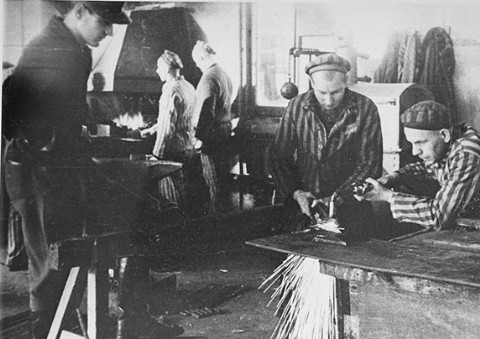 Prisoners at work in
a factory in Auschwitz
Prisoners at work in
a factory in Auschwitz
According to the book by Melissa Müller
entitled "Anne Frank, the biography," Peter van Pels,
Otto Frank, Dr. Fritz Pfeffer and Hermann van Pels were all assigned
to work in the main camp at Auschwitz. Peter was given a job
in the camp post office and the other three were assigned to
manual labor. The following quote is from Müller's book:
By November 1944, Otto too, had reached
the limit of his endurance. Already weakened by hard work and
hunger, he was beaten by his kapo. After that, he no longer had
the will to get up. What happened to him next he described in
a letter of July 1945 to his mother: through the intersession
of a Dutch doctor he was admitted to the hospital and remained
there until the camp was liberated by the Russians on January
27.
After the war when Otto Frank had finally
made his way home from Poland, arriving in Amsterdam on June
3, 1945, he went to the home of Miep and Jan Gies, where he stayed
as their guest for the next 7 years. Otto knew that his wife
had died of tuberculosis in Auschwitz on January 6, 1945, but
he didn't yet know that both of his daughters were among the
35,000 prisoners who had died of typhus in Bergen-Belsen during
the months of February and March 1945. Two months later, after
it had been determined that Anne had not survived, Miep Gies
turned over to him all of Anne's writings which she and Bep had
found on the floor in the annex after the police left.
According to information given to visitors
at the Anne Frank House, Anne heard on the English radio on March
28, 1944 that after the war there would be a collection of diaries
published and this was what prompted her to rewrite her diary.
During the period from May 20, 1944 until her arrest on August
4, 1944, Anne rewrote all the entries in her original diary up
to and including her original entry for March 29, 1944, the day
before she began writing with publication in mind. According
to Anne's own words, her goal was to convert her diary into "a
novel about the Secret Annex."
Anne was planning to hide the identity
of the characters in her novel with fake names. Anne Frank was
to be Anne Robin, the van Pels family was to be called the van
Daan family, and Dr. Pfeffer would be called Alfred Dussel. The
helpers Kleiman and Kugler would be named Koophius and Kraler.
Bep would be called Elli. In the published version of the diary,
only Miep is referred to by her real name.
On May 11, 1944, Anne wrote in her diary,
regarding her ambition to become a famous writer:
"You've known for a long time
that my greatest wish is to become a journalist some day and
later on a famous writer. Whether these leanings towards greatness
(or insanity) will ever materialize remains to be seen, but I
certainly have the subjects in my mind. In any case, I want to
publish a book entitled Het Achterhuis after the war. Whether
I shall succeed or not, I cannot say, but my diary will be a
great help."
On May 20, 1944, Anne wrote in her diary
regarding her plan to rewrite her original diary:
"In my head it's already as good
as finished, although it won't go as quickly as that really,
if it ever comes off at all."
According to the museum exhibit, Otto
Frank organized Anne's papers and typed up what she had written.
The pamphlet handed out at the museum says:
For making a transcript of Anne's
diary notations he uses Anne's loose-leaf pages as the starting
point.
Otto Frank took some entries from each
version which Anne had written and combined them into the final
version, which he published in June 1947 under the title that
Anne had chosen: Het Achterhuis (The House Behind). One of the
1,500 copies that were printed in the first edition of the diary
is on display at the museum.
Otto Frank used his own judgment in editing
his daughter's writing: he left out a few pages, added a few
words here and there and changed a few sentences. He also made
corrections in grammar and punctuation with the help of others
whom he consulted.
All three versions of the diary can now
be read simultaneously in The Diary of Anne Frank, the Critical
Edition, which was prepared by the Netherlands State Institute
for War Documentation and copyrighted in 1986. This is a huge
volume, weighing about 10 pounds, which contains diary entries
that Otto Frank left out of the original version because they
contained embarrassing sexual references. The book also contains
the results of an extensive handwriting analysis which established
once and for all that the diary is genuine, and not a fake as
some neo-Nazis and revisionists have claimed.
Among the items on display in the top
floor museum are letters which Otto Frank wrote to his family
members, after he returned from Auschwitz. He was destitute and badly in
need of money, according to his letters. Also on display is a
tiny date book, the size of a pocket address and telephone book,
in which Otto Frank made notations.
On June 25, 1947, Otto wrote the word
"BOOK" in this date book; this was the date that Anne's
diary was first published in the Netherlands. Her diary was originally
written in the Dutch language and the first edition was published
in that language. Anne's diary has been translated into more
than 60 different languages, and it has become world famous.
Anne Frank has become a symbol for the
millions of Jews whose lives were cut short and whose potential
was never realized. It is hard to fathom six million Jews being
murdered by the Nazis, but Anne Frank has made it easier for
people today to comprehend the concept of one Jew being killed
six million times.
Copies of the book in all the different
languages are on display in a glass case. In a documentary movie,
which is shown at the Anne Frank House, Otto Frank says that
he was amazed by the depth of Anne's emotions when he read her
diary because she had never talked about her feelings. He also
didn't know, until he read it in Anne's diary, that his daughter
Margot was also keeping a diary while the family was in hiding.
Although there have been several investigations,
it has never been determined who betrayed the Franks. There has
been some speculation that the guilty person was a man named
W. G. Van Maaren, who is referred to in the diary as V.M. In
1943, Van Maaren replaced Bep's father as the warehouse foreman.
The Nazis were offering a reward to anyone who turned in the
Jewish families who were in hiding, and as the war progressed,
this became more and more tempting to the Dutch people who were
suffering great hardship. If Otto Frank had any knowledge about
who betrayed his family, he never sought revenge and did not
reveal any information about what he knew.
Otto Frank also did not seek revenge
against Karl Silberbauer, the Austrian police officer who arrested
the occupants of the annex on August 4, 1944, accompanied by
several Dutch Nazi police officers. The number of Dutch officers
varies from 3 to 8, depending on who is telling the story. Silberbauer
was an officer in the Sicherheitsdienst or the SD. This was the
German Security Service. The Dutch officers were Nazi collaborators
who were also members of the SD. The eight people in the annex
were arrested, along with their helpers, Jo Kleiman and Victor
Kugler. All were taken to the SD headquarters in a school building
on Euterpestraat in Amsterdam, and on that same day, Kleiman
and Kugler were taken to a prison in Amstelveenseweg. The 8 people
in the annex were taken to Westerbork, from where they were transported
to Auschwitz. Their Westerbork registration cards are on display
in the museum.
At the time of the arrest, the police
officers thoroughly ransacked the annex and confiscated all the
valuables. Anne's papers had been stored in her father's briefcase,
which the police dumped out onto the floor so they could use
the briefcase to carry away more valuable things that they had
found. After the police left, the papers remained scattered on
the floor, as they apparently didn't realize that the diary and
all the notebooks and loose sheets of paper might contain incriminating
information about who had helped the Franks while they were in
hiding, or even the names of other Jews in hiding. Miep Gies,
who was mentioned as one of the helpers, did not read any of
Anne's writings, after she and Bep retrieved the diary. If she
had, she might have destroyed Anne's writings because both she
and Bep would have been arrested if the diary had fallen into
the hands of the police. Margot's diary was apparently never
found.
Later, the Nazis came back several times
and took all the furniture out of the hiding place. Today tourists
see only the empty rooms, just the way they were left, after
the Franks were arrested.
According to the exhibits at the Anne
Frank House, the 8 people in the annex were taken on September
3, 1944 to Auschwitz; this was the 83rd and last transport of
Jews from Westerbork to Auschwitz. There were 1019 people on
this train: 498 men, 442 women, and 79 children. Of these people,
549 were gassed immediately upon arrival, including all the children
under 15 years of age, according to the museum brochure. Anne
barely made the cut, since she had just turned 15, only three
months before.
The photograph below, which is displayed
on the third floor of the US Holocaust Memorial Museum, shows
the original affidavit signed by Auschwitz Commandant Rudolf
Höss on May 14, 1946, which was presented at the Nuremberg
International Military Tribunal where Höss testified as
a defense witness. Höss was not the Commandant during the
entire time that the death factory at Auschwitz-Birkenau was
in operation. In May 1944, Hungarian Jews were gassed at Auschwitz-Birkenau
during a time when Josef Kramer was the Commandant of the Birkenau
death camp.
The caption of this photograph reads
On May 14, 1946, Rudolf Hoess, the
former commandant of Auschwitz, signed a declaration stating
that during his tenure in office, 2 million Jews had been gassed
at Auschwitz and another 500,000 killed in other ways. Hoess
overestimated the number of Jews gassed by about 1 million.
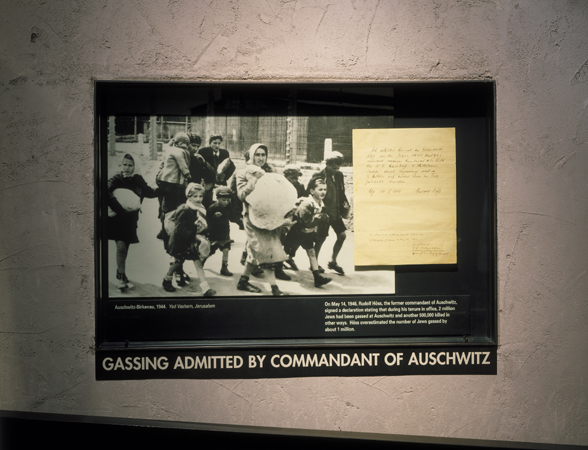
Jews arriving at Birkenau
death camp and original affidavit signed by Rudolf Höss
Photo Credit: US Holocaust
Memorial Museum
Dr. Fritz Pfeffer, the dentist who shared
a room with Anne in the annex, died from sickness and exhaustion
in the Neuengamme
concentration camp on December 20, 1944 according to the museum.
He had been sent to several other camps after he arrived at Auschwitz,
finally ending up at Neuengamme.
Auguste van Pels was "dragged from
camp to camp," according to the museum brochure and she
died "sometime between April 9th and the 8th of May 1945
in the vicinity of Theresienstadt." Mrs. van Pels was transferred
first to Bergen-Belsen with a group of 8 other women on November
24, 1944, then to Buchenwald and finally evacuated to Theresienstadt.
Her son, Peter, was one of the 60,000 prisoners on the death
march out of Auschwitz when the camp was evacuated on January
18, 1945. According to Melissa Müller in her book "Anne
Frank, the biography," Peter had found a protector at Auschwitz.
The following quote is from her book:
After the selection on their arrival
in Auschwitz, Otto Frank, Hermann and Peter van Pels, and Fritz
Pfeffer had all been sent to Block 2 in the main camp, Auschwitz
I. They were lucky. One of the senior men in that block was Max
Stoppelman, whose mother's apartment in South Amsterdam Jan and
Miep Gies were renting part of. Otto Frank had placed the classified
ad that had led Miep to Mrs. Stoppelman, and he had gotten to
know Max on that occasion. With the help of Jan Gies, Max and
his wife, Stella, had gone into hiding with a Dutch family in
Laren in the fall of 1943, but six months later they had been
betrayed and arrested. Peter van Pels, too, became friends with
Max Stoppelman, a short man of about thirty with the shoulders
of a wrestler. [....]
Max Stoppelman's protection and tutelage
had obviously benefited Peter, who seemed surprisingly well nourished.
Peter came to the infirmary to see Otto for the last time in
mid-January 1945. The camp was being forcibly evacuated, Peter
told Otto. Both he and Otto had to leave. Max assured Peter that
if Peter stuck with him on the journey he would come through
fine. Otto tried unsuccessfully to convince Peter to stay.
Peter survived the death march and eventually
wound up in the Mauthausen
concentration camp in Austria, but he died on May 5, 1945, on
the very day that the camp was officially liberated by American
soldiers.
Otto Frank wisely remained behind in
the infirmary in the main camp at Auschwitz when the camp was
evacuated and he was the only one of the 8 people in the annex
who survived. According to Melissa Müller's book, Otto Frank
was among only 45 men and 82 women on the September 3, 1944 transport
of 1,019 prisoners to Auschwitz who survived to the end of the
war.
Auschwitz was liberated by the army of
the Soviet Union on January 27, 1945. The 7,650 prisoners who
had stayed behind were kept in the camp for a few weeks until
they were released and had to find their own way back home.
Otto began his journey home on March
5, 1945 and on the way he met a woman acquaintance, Elfriede
Geiringer-Markovits, who was a survivor of Auschwitz. Her daughter,
who also survived Auschwitz, had been a schoolmate of Anne Frank.
Otto and Elfriede met again in Amsterdam and eventually married
in November 1953. Otto continued his business at 263 Prinsengracht
until he retired in 1955 and moved with his new wife to Switzerland.
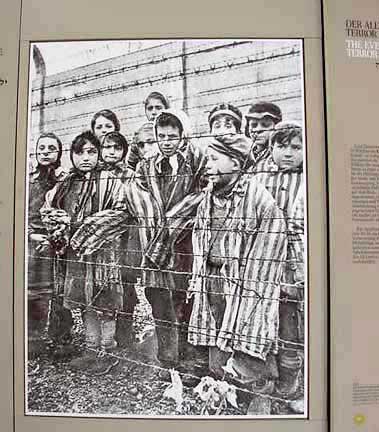
Photo in Bergen-Belsen
Museum shows young Auschwitz survivors
After seeing the exhibits on the top
floor of the 263 Prinsengracht building and in the 265 Prinsengracht
building, visitors then proceed to the modern building at 267
Prinsengracht. Modern steel staircases are used for the descent
so that visitors don't have to go back down the steep stairs
in the annex or in the building at 263 Prinsengracht.
The stairs in the annex are very narrow,
about three feet wide, and as steep as a ladder. The individual
stair steps are not deep enough to place your whole foot on the
stair. I had to place my feet sideways on the steps in order
to climb up. There is a hand rail only on one side. There would
be a great potential for accidents if visitors had to go back
down these steep stairs. It is hard for me to imagine how the
residents of the annex carried coal and food up these steep stairs
for over two years.
At the end of the tour, there is a guest
book for visitors to sign and a clear plastic box into which
one may put money for a donation to the Anne Frank Foundation.
Most of the money in the box was American dollars and most of
the entries in the guest book, when I was there, included American
addresses.
Next, there is a room full of computers
with interactive displays about the Holocaust. Tourists can also
play with software which allows one to move the mouse of the
computer for a virtual tour around the rooms of the annex. Using
this software, I was able to see a photograph of the rear of
the annex where there is a walled garden.
Afterwards, visitors can have a bagel
sandwich in the cafeteria, where there was a display of photographs
of Jewish girls, taken when they were the same age as Anne when
she died. The bookstore has a large selection of postcards and
books about Anne Frank in all the major languages. There is also
a library table where visitors can sit and read some of the books
about Anne Frank.
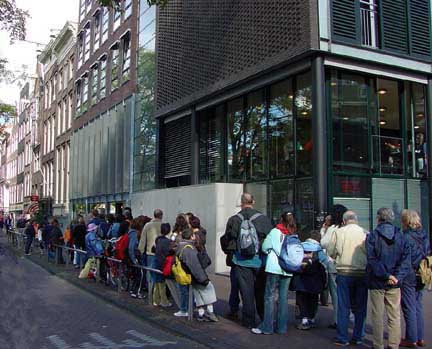 Cafeteria in modern
building at 267 Prinsengracht overlooks street
Cafeteria in modern
building at 267 Prinsengracht overlooks street
At the end of the tour, I saw an interactive
exhibit entitled "Out of Line" which was in the building
at 267 Prinsengracht. This was a special exhibit which was removed
in 2003.
Regarding the Out of Line exhibit, the
brochure says that:
(It) is an example of the attention
being paid to current issues at the Anne Frank House - issues
that are also being developed in educational materials for classroom
use.
The Out of Line exhibit room had two
movie screens, side by side, where short film clips about the
issues of the day were being shown in September 2002. There were
metal stools, which had been placed in a U shape around three
sides of the room. In front of each stool was a metal stand with
two buttons, one green and one red, which visitors could press
to vote on what had just been presented in each film clip. As
the votes were entered, green and red lights flashed on the ceiling
to show how the people in the room had voted. The choice was
between freedom of expression and the right to be free from discrimination.
Freedom of expression got the green light and the rights of minorities
got the red light. The brochure about the exhibit pointed out
that "many western countries have laws forbidding the public
expression of discriminatory or racist sentiments."
This quote is from the Out of Line brochure:
We're asking you, the visitor, to
consider these real cases of clashing rights and to make a choice
and take a stand. Is there a limit to freedom of expression in
a democracy, and if so, where do you think the line should be
drawn? In this exhibition, you and the other visitors will decide
where to draw the line, based on examples.
While I was there, the visitors used
the red light to vote against freedom of expression on most of
the examples. There were only two issues that got the green light:
One was the right of hip-hop artist Eminem to freely express
himself even though his lyrics are offensive, insulting and humiliating
with regard to women and gays. The other was the right of a TV
advertiser to show a teenaged boy with half of his face burned
by fireworks. The TV ad depicts a scenario where the boy has
trouble making friends because his face has been marred by a
fireworks accident, an implication which is an insult to the
physically handicapped. On all other issues, the visitors were
unanimous in condemning any freedom of expression which insults
or discriminates against minorities.
After visiting the Anne Frank House,
many tourists go to the Westerkerk plaza to have family members
take photographs of them standing by the statue of Anne Frank,
which is at the corner of Prinsengracht street and the Plaza.
I had to wait a long time for my turn to take the photograph
of the statue which you see below.
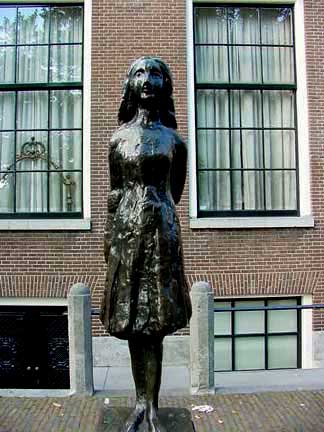 Statue of Anne Frank
is favorite spot for tourist photographs
Statue of Anne Frank
is favorite spot for tourist photographs
The brochure, which visitors receive
with their ticket, ends with these words about the purpose of
the Anne Frank Foundation:
Furthermore, the Anne Frank House
trains and advises schools, businesses, and other organizations
in the field of multicultural policy making. The educational
mission is also carried out internationally by means of teaching
materials and traveling exhibitions. Sister organizations are
active in New York, London and Berlin.
To contact the Anne Frank Foundation,
one can write to this address:
Anne Frank House, P.O. Box 730, 1000
AS Amsterdam, The Netherlands
This page was last updated on March 16,
2009
|